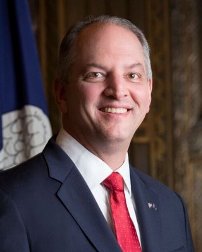A Review of State Executive Partisan Outliers
One party controls every elected executive office in all but 14 states

Over the last year, Smart Politics documented the rise of single-party state congressional delegations, how major parties currently have record U.S. Senate winning streaks in two-dozen states, how two-thirds of states have governors and U.S. Senators from the same political party, and how the 117th Congress has the fewest split U.S. Senate delegations in history.
Four years ago this month, Smart Politics highlighted the half-dozen states in which a lone Democrat or Republican held directly elected statewide executive office, with all other such offices held by the other major party. [Note: A small number of states were excluded from analysis as they fill only one executive partisan office via direct election (governor) – Maine, New Hampshire, and Tennessee].
At the time of that report, 18 states had at least one member from each major party in a directly elected executive office.
That number has dropped to 14 states today: Arizona, Florida, Iowa, Kansas, Kentucky, Louisiana, Maryland, Massachusetts, Missouri, Nevada, North Carolina, Pennsylvania, Vermont, and Washington.
And one major party just holds a single executive office in six of these states:
- Florida: Democratic Commissioner of Agriculture and Consumer Services Nikki Fried
- Louisiana: Democratic Governor John Bel Edwards (pictured at top)
- Missouri: Democratic Auditor Nicole Galloway
- Nevada: Republican Secretary of State Barbara Cegavske
- Vermont: Republican Governor Phil Scott
- Washington: Republican Secretary of State Kim Wyman
Edwards, Galloway, and Scott are the three holdovers from this list in 2017.
As for the others, Mississippi Attorney General Jim Hood lost his gubernatorial bid in 2019 and Oregon Republican Secretary of State Dennis Richardson died in office in February 2019 (Democrats picked up the latter seat in 2020 for a clean sweep).
Meanwhile, long-serving Wisconsin Democratic Secretary of State Doug La Follette was part of an executive office sweep by his party in 2018.
Fried is running for governor in 2022, Galloway is retiring from elected office in 2022, and Bel Edwards is term limited in 2023, so this list may shrink in the coming year.
Democrats currently hold all directly elected executive offices in 15 states (excluding Maine) – up from eight states four years ago: California, Colorado, Connecticut, Delaware, Hawaii, Illinois, Michigan, Minnesota, New Jersey, New Mexico, New York, Oregon, Rhode Island, Virginia, and Wisconsin.
Republicans hold all such offices in 18 states (excluding New Hampshire and Tennessee) – down from 20 states in 2017: Alabama, Alaska, Arkansas, Georgia, Idaho, Indiana, Mississippi, Montana, Nebraska, North Dakota, Ohio, Oklahoma, South Carolina, South Dakota, Texas, Utah, West Virginia, and Wyoming.
The GOP now controls 59.9 percent of the nearly 300 state executive offices across the nation – falling from 68.9 percent from four years prior.
Follow Smart Politics on Twitter.

To whom it may concern, Remove states where Lt. Gov. is elected as a ticket with the Gov. means AK, HI and NJ would only have the Gov. elected, KY only has a Dem. Gov. whilst MD and MA only have Rep. Gov.’s. In KS, the Dem state treas. was appointed to fill a vacancy rather than being elected to the office. I anticipate that MO and FL in 2022 and LA in 2023 will have clean gop sweeps. KS in 2022, if they beat the apt. Treas. and gov. Laura Kelly and KY in 2023, if the beat gov. Andy Beshear could be gop sweeps too. Dem.’s sweeps in MD and NV seem likely, possibly MA and VT too. It just all depends on what happens. With all of that said, I’m out.
At first blush I would agree with this, except there are (rare) instances of gubernatorial tickets that are not from the same party. For example, the winning 2014 ticket in Alaska was an independent (Bill Walker for GOV) and a Democrat (Byron Mallot for LG).
In 1864 the winning presidential ticket comprised of a Republican and a “War Democrat”. As well, in 1972 and 2004 the D nominees actually toyed with selecting a Republican (M O Hatfield and J S McCain, respectively) as their running mates. More seriously and four years on, McCain’s reported first choice for vice presidential nominee was not a member of the Republican Party in good standing.
“As for the others…” John Perdue (6-term Democratic Treasurer of WV; “pictured” in August 2017) lost his bid for re-election in 2020, unable to weather a perfect storm of lopsided losses for his presidential and gubernatorial ticketmates and an opponent from a prominent family (Riley Moore, a progeny of Governor Arch Moore).
VT: Had David Zuckerman remained in executive office – whether as lieutenant governor or governor – he would have made the “partisan outlier” list – as a member of the VERMONT PROGRESSIVE PARTY.
NV: With a 48.9% to 48.3% squeaker in 2018, Secratary of State Barbara Cegavske barely made the short list of outlier constitutional executive officer in her state – a dramatic reversal of fortune for her party, which made a clean sweep just four years prior.
With the defeat in 2020 of one-term Treasurer Duane Davidson, three-term SoS Kimberly Marie Wyman is not only the sole executive officer of her party in her state, but also the entire mainland Pacific Coast. However, that latter distinction may not last much longer, if a majority of CA voters recall embattled Governor Newsom next month (no prominent Democrat entered, thus the “replacement race” if activated will assuredly be won by a Republican).
[…] A Review of State Executive Partisan Outliers […]